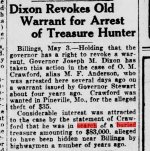Needs more Research
Great Falls tribune. (Great Falls, Mont.), 04 May 1921.

https://chroniclingamerica.loc.gov/...=&proxValue=&dateFilterType=yearRange&page=31
Great Falls tribune. (Great Falls, Mont.), 04 May 1921.

https://chroniclingamerica.loc.gov/...=&proxValue=&dateFilterType=yearRange&page=31










